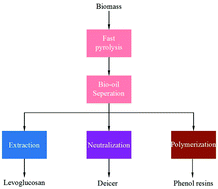Life-cycle assessment and techno-economic analysis of the utilization of bio-oil components for the production of three chemicals†
Abstract
Bio-based chemicals have gained more widespread attention than bio-fuels because of the decline in crude oil prices. The development of technologies to produce chemicals from bio-oil is potentially attractive because of the simplicity of bio-oil preparation. This study presents a prospective and detailed techno-economic life-cycle assessment for the joint production of levoglucosan, phenol-formaldehyde resins, and noncorrosive road deicers using fast biomass pyrolysis, bio-oil fractions, and a purification pathway by modeling a 60-dry-metric-ton biomass per day facility. In particular, life-cycle environmental metrics (i.e., global warming potential 100a, cumulative energy demand, and eco-indicator 99) as well as the 20-year facility internal rate of return (IRR) are determined, and uncertainty analysis is performed to provide deeper insight into the effect of these model parameters and the reliability of model predictions. It is found that bio-oil (BO)-derived levoglucosan was fairly environmentally competitive, BO-resin was promising under environmental aspects, and BO-deicer possessed fairly poor environmental profiles. On the basis of the life-cycle inventory assessment in this study, two slightly universal conclusions could be further proved: (1) if the consumption of the chemical and energy auxiliaries provided by nonrenewable resources is too large in a biomass-based process, this process could achieve higher environmental impacts compared with conventional production from nonrenewable resources, and (2) an increase in the product yields could effectively reduce the environmental footprint of this production process. For the biorefinery process, the facility IRR is 29.6%. The GWP100a (22.3 kgCO2-eq kg−1), CED (484 MJeq kg−1) and EI-99 (1.91 points per kg) values for BO-deicer production are much higher than that for BO-LG (2.19 kgCO2-eq kg−1, 29.7 MJeq kg−1 and 0.151 points per kg) and BO-resin (0.934 kgCO2-eq kg−1, 32.7 MJeq kg−1 and 0.134 points per kg). The techno-economic analysis results showed that this project is commercially attractive, and the economic environment presents a low risk to the project investment.

- This article is part of the themed collections: Measuring Green Chemistry: Methods, Models, and Metrics and 2018 Green Chemistry Hot Articles


 Please wait while we load your content...
Please wait while we load your content...